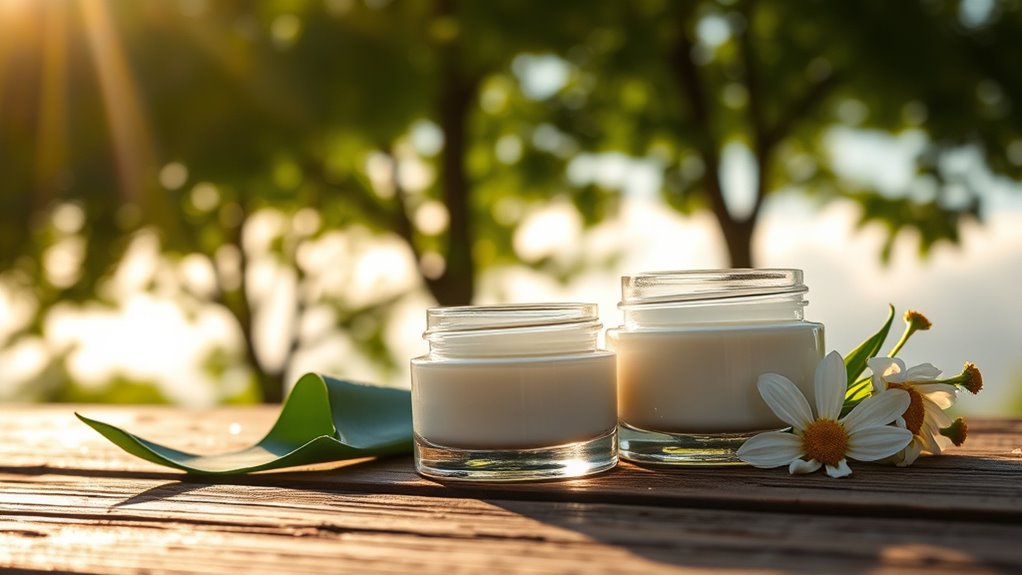To adapt your skincare for weather changes, tailor your routine to environmental conditions. Use hydrating products like hyaluronic acid during dry, cold days, and switch to lighter, oil-free formulas in humid weather. Remember to apply broad-spectrum sunscreen daily and reapply often, especially in winter or near water. Pay attention to your skin’s signals—if it feels tight or dull, boost hydration. If you want to discover more weather-adaptive tips, keep exploring how climate influences your skin.
Key Takeaways
- Adapt hydration routines by using lighter products in humid weather and richer creams in dry, cold conditions.
- Apply broad-spectrum sunscreen daily and reapply frequently, especially in snowy or reflective environments.
- Adjust skincare products based on climate: use barrier-repair ingredients like ceramides in dry weather and oil-free formulas in humid conditions.
- Recognize environmental signals like tightness or dullness to proactively modify hydration and protection strategies.
- Stay informed about weather patterns to tailor skincare routines, ensuring skin remains healthy and resilient year-round.

Have you ever wondered how your skincare routine should change in response to climate change? As the weather becomes more unpredictable—hotter summers, colder winters, increased sun exposure—you need to adapt your skincare to keep your skin healthy and protected. Climate-smart skincare involves adjusting your hydration routines and sun protection strategies to match the climate conditions you’re facing. Staying hydrated is more important than ever, especially when heat and humidity can dehydrate your skin faster. Incorporate hydrating serums or moisturizers that contain hyaluronic acid or glycerin into your daily routine to help your skin retain moisture. Don’t forget to drink plenty of water throughout the day, as internal hydration directly impacts your skin’s appearance and resilience. When the sun blazes, your skin needs extra defense, so prioritize sun protection. Apply a broad-spectrum sunscreen with at least SPF 30 every morning, and remember to reapply every two hours if you’re outdoors. If you’re near water or in a humid environment, sweat and moisture can wear down your sun protection, so be diligent with reapplication. On colder days, your skin might not feel as vulnerable to UV rays, but the sun’s rays can still cause damage, especially if you’re snowboarding or skiing, where reflection intensifies UV exposure. Even during winter, continue using sun protection to prevent premature aging and skin damage. Humidity levels can also influence your skincare, as high humidity might make you feel greasy and cause breakouts, prompting you to switch to lighter, oil-free hydration routines. Conversely, dry air can strip moisture from your skin, so you might need richer creams or occlusive products to lock in hydration. Pay attention to your environment—air conditioning and heating can dry out your skin, so incorporate hydrating routines that include barrier-repair ingredients like ceramides to bolster your skin’s defenses. Adjusting your skincare for climate change isn’t just about layering products; it’s about understanding how weather impacts your skin and acting proactively. Use lighter textures in humid conditions, and switch to more nourishing products in cold, dry weather. Always listen to your skin’s signals—if it feels tight or looks dull, it’s time to boost hydration or increase sun protection. Climate-smart skincare means being flexible, staying informed about weather patterns, and tailoring your routine accordingly. Understanding how weather impacts your skin and the importance of adjusting your skincare routine can help you maintain healthy, resilient skin, no matter what the weather throws your way.
Frequently Asked Questions
How Does Humidity Affect Skincare Routines?
Humidity fluctuations directly impact your skincare routine by influencing skin hydration levels. When humidity is high, your skin naturally retains more moisture, so you can use lighter moisturizers and avoid overloading it. Conversely, low humidity causes your skin to lose moisture faster, so you should boost hydration with richer creams and hydrating serums. Adjusting your products based on humidity helps maintain a balanced, healthy complexion regardless of weather changes.
Can Weather Changes Cause Long-Term Skin Damage?
Weather changes can indeed leave a lasting mark on your skin, like a painter’s brushstroke etched into a canvas. Sun exposure, especially during summer, can weaken your skin’s elasticity, leading to sagging and premature aging. Over time, fluctuating temperatures and humidity levels can compromise your skin’s barrier, causing long-term damage. Stay vigilant, protect your skin, and adapt your routine to weather’s whims to preserve your youthful glow.
Which Ingredients Are Best for Winter Skincare?
For winter skincare, you want ingredients for dry skin like hyaluronic acid, glycerin, and ceramides, which hydrate and lock in moisture. Nourishing winter moisturizers often contain shea butter or jojoba oil, providing deep nourishment. These ingredients help combat the harsh cold, prevent cracking, and keep your skin soft and resilient. Make sure to apply a rich moisturizer daily and consider layering with occlusive agents for extra protection.
How Often Should I Adjust My Skincare Seasonally?
You should adjust your skincare seasonally every few months, like changing the layers of clothing you wear. As weather shifts, switch to a seasonal moisturizer that suits the new conditions and remember to incorporate sun protection even during colder months. Think of your skin as a garden; watering and nourishing it according to the season keeps it healthy and resilient, ready for whatever weather comes your way.
Are There Specific Products for High-Altitude Skin?
Yes, for high-altitude skin, you should look for products that address altitude-induced dryness and offer high-altitude sun protection. Choose a hydrating moisturizer with ingredients like hyaluronic acid to combat dryness caused by lower humidity. Additionally, use a broad-spectrum sunscreen with high SPF to protect your skin from intense UV rays at higher elevations. These products help maintain your skin’s health and prevent damage in challenging high-altitude environments.
Conclusion
As you adapt your skincare to shifting weather patterns, imagine the next season’s surprises—unexpected cold snaps or scorching days. Will your routine hold up against these changes? Staying climate-smart means you’re prepared for whatever nature throws your way. Keep experimenting, stay vigilant, and your skin will thank you. But beware: the weather’s unpredictability might just surprise you when you least expect it. Are you ready to face what’s coming next?








